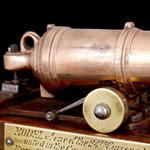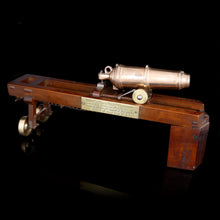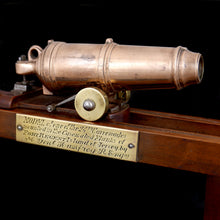Royal Engineers - Model of a Bronze Carronade, 1810
SOLD
Tax included.
Adding product to your cart
Length: 29.8cm (11.75in)
Bronze and mahogany. Ordnance model of a 24-pounder bronze carronade, with tapering sighted barrel cast with raised mouldings, the cascabel button with elevating screw and integral breeching loop, the wooden platform with iron and bronze mounts, the right side applied with a brass plaque inscribed 'Model of one of the 24pr carronades mounted in the Casemated Flanks of Fort Regent Island of Jersey by M. Genl. Humphrey R. Engrs.’
Fort Regent was the principal fortification on Jersey during the Napoleonic Wars. It was largely constructed under the direction of Lieutenant-General John Humfrey (c.1756-1832), Colonel Commandant of the Corps of Royal Engineers. He was commissioned 2nd Lieutenant into the Royal Engineers in 1776, became Lieutenant 1783, Captain 1793, Major 1802, Lieutenant-Colonel 1805 and Major-General on 4 June 1814.
General Humfrey’s task in strengthening Jersey’s defences was no doubt given urgency by the memory of the French invasion of 1781 during the American Revolutionary War. Only 14 miles off the coast of France, and placed on the principal sea-borne supply route to the French naval base at Brest, Jersey was of strategic importance during any war between Britain and France. Large numbers of privateers operated out of the island, causing chaos amongst French merchant shipping. Accordingly the French government of Louis XVI decided to neutralize this threat. On that occasion the French landed a 1,000 men but the expedition ultimately failed. Its commander, Baron Philippe de Rullecourt, died of wounds sustained in the fighting. The battle is better remembered for the death of the British officer Major Peirson, and a painting based on his final moments by John Singleton Copley. The mounting of 24lb carronades, aka the ‘smasher’, would have undoubtedly beefed up the defences in the Napoleonic era.
The carronade was invented by General Robert Melville (1723–1809), the son of a Scottish minister, who persuaded the Carron Company in Falkirk to manufacture the guns - hence the name ‘carronade’. Our model may well be a maker’s model presented by the Carron Company to General Humfrey in gratitude for what would have been an important Government contract in the Regency period.
Use left/right arrows to navigate the slideshow or swipe left/right if using a mobile device






